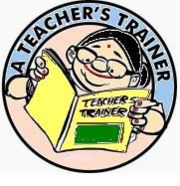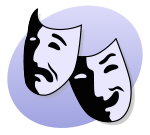Experimental learning
LET US KNOW ABOUT EXPERIENTIAL LEARNING
|
EXPERIENTIAL LEARNING One of the ways in which a transaction in a training context can take place is through experimental learning. In this mode, the trainees act as learners and do whatever a learner is supposed to do. This experience gives them insights into how learners learn (strategies) and what training/teaching strategies work in class. Read the study material Conceptual Basis of Experiential Learning to know the conceptual basis. |
Topics / Themes
Any -content area can be used as the topic/theme for experiential learning, for ex- ample, initial reading, life science topics etc.
Time
If a session is for 45 minutes, 30 minutes can be used for experiential learning. The rest of the time can be set a part for a plenary where the experience of the group is gathered and consolidated.
Types of experiential learning
There are two main ways in which experiential learning can be set up
a) Peer demonstration & observation
o Here the trainer divides the class into ‘trainees’ and ‘observers‘. The ‘trainees are put through the ‘class’
o The ‘observers’ observe the ‘lesson’ for points of methodology,
o At the end of the ‘class’ the group gets together and discusses the experience from the point of view of ‘observers’ and ‘trainees’
o The discussion is consolidated
b) Whole group work.
Here the whole group undergoes the ‘experience’ of learning. At the end of the class, the trainer elicits important points through discussion and consolidates them.
| Send the Completed Activity Sheet to:
bhatvd@yahoo.co.in |
|
|
1) What types of topics lend themselves to experiential learning? Tick your choice. a. Note making b. Media in education c. Simultaneous equations d. Theory of relativity 2) Give reasons for your choice. 3) From the choice you have made above, design an experimental activity. Design it for 20 mins for a class of 30 adult learners.
|
Organising Activity based learning
Activity based learing is also an approach used for providing concrete experiences in learning.
| Introduction
All children are naturally motivated to learn and are capable of learning and it takes place both within and outside the school.Though children learn in a variety of ways both individually and in groups the NCF 2005 states that the children require opportunities to learn through making and doingthings,experience,experimentation,reading,discussing,listening,thinking and reflecting and expressing oneself in speech,movement and writing. Even the NPE1986 advocated a 'child-centred and activity based process of learning'. Therefore, it becomes the responsibility of the teacher to create a learning environment by following an appropriate approach and help children to construct their knowledge. |
Useful Web linksThese web sites have some material on activity based learning http://www.ucalgary.ca/~corbett/virtual_instructors/index.htm http://www.mikeandken.com/ http://www.hindu.com/2007/04/02/stories/2007040204000200.htm http://college.hmco.com/education/pbl/background.html#Features |
| Send the Completed Activity Sheet to:
bhatvd@yahoo.co.in |
|
Conducting Role Play
The word 'role' implies accepting a part in a sequence and play means acting it out. Role play is more flexible compared to a drama. The drama will have a fixed theme, the conversations being prefixed, the sequence of events being rigidly followed etc. The role play does not have any one of these.
| Send the Completed Activity Sheet to:
bhatvd@yahoo.co.in |
|
In a role play the theme may be there, but the conversations will have to be evolved by a group of students or actors. Sometimes role play is done without having necessary rehearsals.
The steps of role play are like this.
- Fixing a theme or deciding on a theme which is topical .
- Deciding on the type of role play, the type of roles, the number of students required and developing the conversation in a flexible manner.
- A small rehearsal, where the conversations are evolved.
- Enacting the role play
- Feedback by the teacher or the teacher educator
When you consider a textual content the steps might change. For example, when you want your students to practice a particular function in a language learning situation, you might use the dialogues given in the lesson.
| Send the Completed Activity Sheet to:
bhatvd@yahoo.co.in |
|
The themes may be like water problem in your city, discrimination of castes in the locality, the beggars’ problem etc. The number of roles and actors gets decided on the theme selected.
| Send the Completed Activity Sheet to:
bhatvd@yahoo.co.in |
|
|
Taking a problem of your city develop a small skit. Develop the conversations which is subject to change depending on the actors. Feedback by the teacher or teacher educator is a special aspect in role play, as it is used in educational settings. ____________________________________________________________________________________________ ____________________________________________________________________________________________ ____________________________________________________________________________________________
|
In the above listed approaches who plays a major role? Is it you or your students?
Examine each of the activity and write what role is played by the teacher and what role is played by the students in performing that activity.
Let us take the example of role play.
There are certain approaches whrein students play a major role and learn by doing. They perform certain activities.Name some educational activities that can be taken up in your class, major tasks being performed by the students.
Example:Preparing charts
____________________________
_______________________
Let us now pick some of the above activities and try to organise them in the class by relating them to to a lesson.
Which activities did you choose?
_______________________________
_______________________________
_______________________________
_______________________________
To which subject and topic would you like to relate?
Subject____________________Topic______________________
Let us plan for organising activities in Social Sciences on the topic OUR AGRICULTURE.
No. of students: 40
No. of groups: 8 No. of members in each group: 5
Sub topics:
Group 1: Meaning and types of agriculture
Group 2: Condition of Indian agriculture before Independence
Group 3: Progress made in Indian agriculture after Independence
Groups 4,5 and 6:Food crops
Groups 7 and 8: Cash crops
Activities required to be performed by each group:
- Collecting information
- Preparing charts and maps(wherever needed)
- Collecting samples(wherever possible)
- Downloading pictures from internet
- Group discussion
Time given for making preparation: Two weeks
Time given for performing the activities in the class(final form):Four teaching hours
Time given for group presentation of the work followed by discussion:30 minutes per group
What instructions would you like to give to the students from forming the groups till the dicussion?
______________________________________________________________________________________
______________________________________________________________________________________
| Send the Completed Activity Sheet to:
bhatvd@yahoo.co.in |
|
|
Try this activity in the class and find out what are the outcomes of the activities. _______________________________________________________________________________________________ _______________________________________________________________________________________________ Will you try to organise another activity to teach some other subject or topic?
|
Organising Dramatisation
All of us have seen dramas, both traditional and modern. There are different types of stage presentations like absurd theatre, street plays, yakshagana, etc. We all know that dramas have entertainment value. Do they also have educational value? Can we use the theatre techniques for enhancing classroom learning?
The drama means a pre-decided set of conversations spoken out, with acting of the actors, accompanied by gestures, music and dance and with special effects as the case may be.
The drama invariably has a pre-decided written parts, be it in languages, social studies or sciences. The ready made drama in science are very small in number, but the dramas in languages and social studies are many. It requires an interested teacher to identify the theatrical part in the lesson and sometimes he or she develops the conversations too. He/she has to identify students who have a knack for acting and allot roles to them. Rehearsals are many in number with or without music or costumes. To start with there may not be music in instruments but slowly they are all introduced.
| Send the Completed Activity Sheet to:
bhatvd@yahoo.co.in |
|
The steps involved in dramatisation are
- Determining the theatrical element in the lesson
- Searching and finding a play suited to that theme in the lesson
- Modifying the play to suit the lesson
- Deciding on the students who would fit the different roles in the drama
- Allotting roles to different students and asking them to copy down their part of the conversation
- Giving time to the students to mug up the conversations and understand the theme of the play
- Rehearsals as many as required
- Rehearsals with costumes on
- Enactment of the drama
- Feedback on the suitability of the drama to the historical theme or linguistic theme, the actors, their acting etc.
| Send the Completed Activity Sheet to:
bhatvd@yahoo.co.in |
|
In dramas of schools and colleges the costumes may not be custom made or from a theatre company. They may be improvised, somewhat ordinary compared to professional dramas.
Some dramas are action oriented but others are speech oriented. The teacher or the teacher educator has to take a decision regarding the theme and the type of actors available in the school. For example, the drama on ‘Krishna, the child’ will have more action and special effects, where as the drama on ‘Kitturu Rani Chennamma’ will have more emphasis on words.
The teacher has to keep in mind the cost involved, time available and the school’s philosophy before deciding on which drama to stage.
Many dramas require permission to be taken by the original authors. Courtesy demands that the author is requested for permission in advance and the royalty if any, can be paid.
You can download Activity Sheet from here Activity Sheet-Organisisng Group Based Activities



